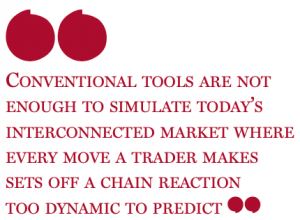The Banker features Justin Lyon in a look at how a scientific approach can take data simulation to the next level.
Excerpt
No one really knows how much value is lost because of poor equity trade execution. Current algorithms, relying on heuristics or machine learning, aim to capture and optimise the execution of trades to minimise market risk, impact and price slippage.
Each evolution of an algorithm relies on meaningful data sets for testing before deploying in the real market. The challenge, however, is finding and interacting with these meaningful data sets.
The simulators based on replays of historical data currently in use are outdated and serve only to reconstruct past events, something further complicated by the fact that any given event in the past may never happen again or in the same way.
Conventional tools are not enough to simulate today’s interconnected market where every move a trader makes sets off a chain reaction too dynamic to predict. Think of interconnected events branching off
in an infinite number of directions. The market is a complex ecosystem that adapts to trading behaviours as they occur, as trades are made and as reactions to potential panic or an upside surprise happens in real time.
The solution is to collect anonymised historical data sets and build on these with simulated data based on emerging modelling techniques. Advancements in technology enable us to bring together two things. The first is data from all kinds of sources – the ‘big data’ that sur- rounds us – which can be fed into a variety of machine- learning algorithms to generate insight. The second is using next-generation emerging modelling techniques – that is, agent-based modelling that uses insights from the natural sciences and advancements in cloud computing – to more accurately capture and simulate what really happens in the capital markets.
SPECIAL AGENTS
The Bank of England has issued a number of papers, and chief economist Andy Haldane has commented on the role of agent-based modelling (ABM) in banking supervision.
Furthermore, considering the Markets in Financial Instruments Directive (MiFID II) and the drive for best execution, there is also interest in experimenting with big data, ABM and computational simulation in the capital markets.
Robert Barnes, CEO of Turquoise, says that the trading venue could use its MiFID public data to seed a life-like sandbox reflective of a real equity market that can serve as a simulator tool for its members.
Cloud-based computing power and data storage are cost-effective enough for widespread use with artificial intelligence, simulation and machine-learning technology.
